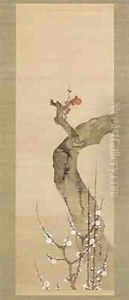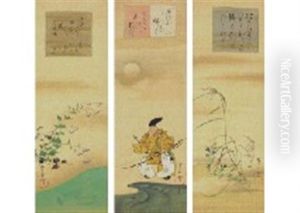Sakai Oho Paintings
Sakai Oho was a Japanese painter known for his contributions to the nanga (literati painting) movement in Japan, which flourished during the Edo period. Born in 1808 in Kyoto, Japan, into the Sakai family, he was deeply immersed in the rich cultural and artistic heritage of the city from a young age. His father, Sakai Hoitsu, was a prominent painter who played a crucial role in reviving the Rinpa school of Japanese painting. Under his father's guidance, Oho developed a profound understanding of both traditional Japanese aesthetics and the more individualistic and scholarly approach of the nanga painters, who sought to emulate the literati painting traditions of China.
Oho's artistic journey was characterized by a blend of his father's Rinpa influence and his personal inclination towards the Chinese literati style. His works often depicted traditional Japanese themes, such as landscapes, flowers, and birds, but executed with a simplicity and spontaneity inspired by Chinese art. This fusion created a distinctive style that was both deeply rooted in Japanese traditions and refreshingly innovative. Despite his relatively short life, Oho's contributions to the nanga movement were significant, as he managed to bridge the gap between the Rinpa school's decorative elegance and the more subdued, introspective qualities of literati painting.
Tragically, Sakai Oho's life was cut short when he passed away in 1841, at the young age of 33. However, his legacy lived on through his artworks, which continued to inspire subsequent generations of Japanese artists. Oho's unique blend of Rinpa elegance and literati simplicity remains a significant chapter in the history of Japanese art, highlighting the dynamic exchange of ideas between Japan and China during the Edo period. His ability to harmonize different artistic traditions serves as a testament to his creative genius and his lasting impact on the development of nanga painting in Japan.

